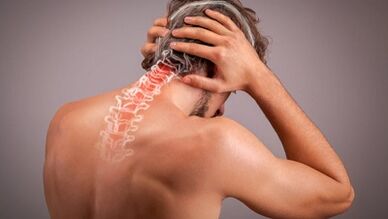
Cervical osteochondrosis occurs more frequently in medium -sized people as a result of a sedentary lifestyle and the influence of other factors.In the context of cartilage destruction, nerve roots are squeezed, which becomes the cause of severe pain.
The symptoms of the disease in men and women have some differences.The pathology has a paroxysmal in the nature of the course, and with the appearance of pain and other signs, a doctor's help is required.
Cervical osteochondrosis symptoms in women
In the initial development stage, cervical osteochondrosis manifests itself in women in the form of regular headaches.The pains are paroxysmal, they can be located in temples, a back of the head and a front.
In addition, the signs of the disease are:
- Feelings of stiffness and discomfort in the neck.
- Fingertips of fingers.
- Dizziness.
- Coordination violation.
- Painful sensations in the limbs, shoulders.
- The sensation of numbness of the language.
Over time, the disease progresses, the pathological process affects the deepest layers of cartilage tissue, reaches intervertebral discs, the following symptoms occur:
- Violation of blood pressure.
- The paleness of the skin.
- Restriction or loss of motor activity.
- Nausea, vomiting.
The first signs of the development of the osteochondrosis of the cervical column are the pain in the neck and a deterioration in the well.There is constant fatigue, headaches.This is due to the fact that in the cervical region vertebrates are quite close to each other, which causes the development of symptoms in the early stages of the progression of the disease.
Signs of cervical osteochondrosis in men
In male patients, the symptoms of cervical osteochondrosis are much brighter.That is why it is much easier to identify the disease.
Pathology signs include:

- Pain.It appears alone on the neck, but then begins to give it to the hands, shoulder, the back of the head.This is due to the muscle tissue spasm located between the bone and the occipital neck.In addition, the cause of painful sensations is a pinch of nerve endings, which leads to the beginning of the inflammatory process.
- Violation of sensitivity.It appears in cases where the pathological process affects the nerve, which is responsible for the transmission of nerve impulse.
- Weakness.It occurs at the bottom of the nervous end lesion, which is responsible for the motor activity of the upper extremities and drives the moving muscles.
- The appearance of a characteristic crystal and rape of motor activity.The lack of therapy can cause a complete loss of mobility.This condition is due to the formation of osteophytes at the edges of the vertebrae and the damage to the small joints.
- Dizziness, coordination violation.In the context of the development of osteochondrosis, there is deterioration in blood circulation in the brain.
- Vision or audition violation, language numbness.These characteristics are manifested only in the posterior stages, when the pathological process affects the extensive areas of cartilage and bone tissue.
- Struggle.Cervical osteochondrosis is characterized by the appearance of a coma in the throat.Many patients often confuse this symptom with a cold sign.In this case, cold therapy does not bring relief, and osteochondrosis continues to progress.The lump and lump in the throat in men often occur at night, causing the appearance of a feeling of fear.
The signs of osteochondrosis in men occur with greater intensity than in women, and often the doctor has no doubt about the diagnosis.
How to reduce cervical osteochondrosic syndromes
To reduce pain, root syndromes and others of the disease, experts recommend performing a series of the following actions during the attack:
- Heat the neck where the pain arose.To do this, you can use a wool scarf.In some cases, cold helps eliminate pain, but should be applied only under the supervision of a doctor.
- Put a special tire in the neck, which consists of several layers.The first is a 2-3 layer bandage.Then a cotton wool is placed, whose layer must be twice larger.Then use cardboard.Fix everything with a bandage.
- Call an ambulance and take anesthesia, if an attack cannot be supported.
To stop pain syndrome, the specialist prescribes several drug groups:

- Non -steroidal anti -inflammatory medications.With the development of cervical osteochondrosis, medications are prescribed in the form of tablets or ointments.They help relieve pain and stop the spread of the inflammatory process.These medications should be used with caution, as prescribed by the doctor and only in these doses, since they have side effects.
- Condroprotectors.Shown for use from the first day of the attack.The duration of the admission is at least six months.They are not intended for the rapid elimination of pain.These drugs affect the very cause of pain, helping to restore cartilage tissue.This effect is achieved due to medications contained in the drugs of sulfate and glucose chondroitin, which help saturate tissues with nutrients and trace elements, and stimulate the regeneration process.
- Musorelaxantes.They are prescribed an acute attack of cervical osteochondrosis.The duration of admission is determined by the treating doctor depending on the severity of pain.A positive effect is achieved by eliminating the spasm of muscle tissue, which leads to an improvement in the condition.
All medications are prescribed only by a specialist.To reduce pain after stopping the acute period, physiotherapy and exercise therapy are carried out.
The symptoms of cervical osteochondrosis in men and women are similar, but in male representatives they are more pronounced.The treatment with attacks must be integral and aimed not only to eliminate pain, but also to the restoration of cartilage tissue.With timely therapy, the remission period is long and the signs of the disease do not occur for a long time.


















